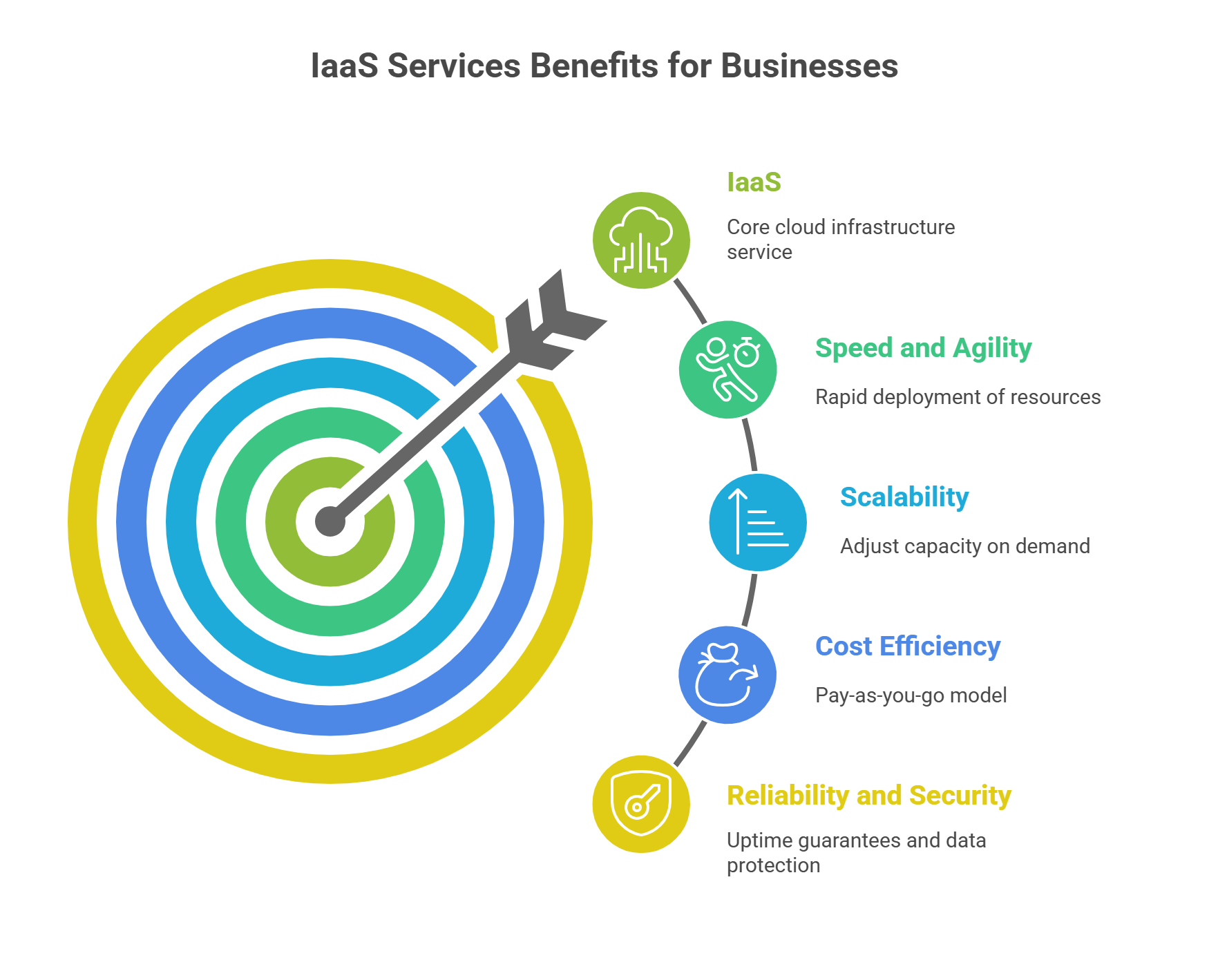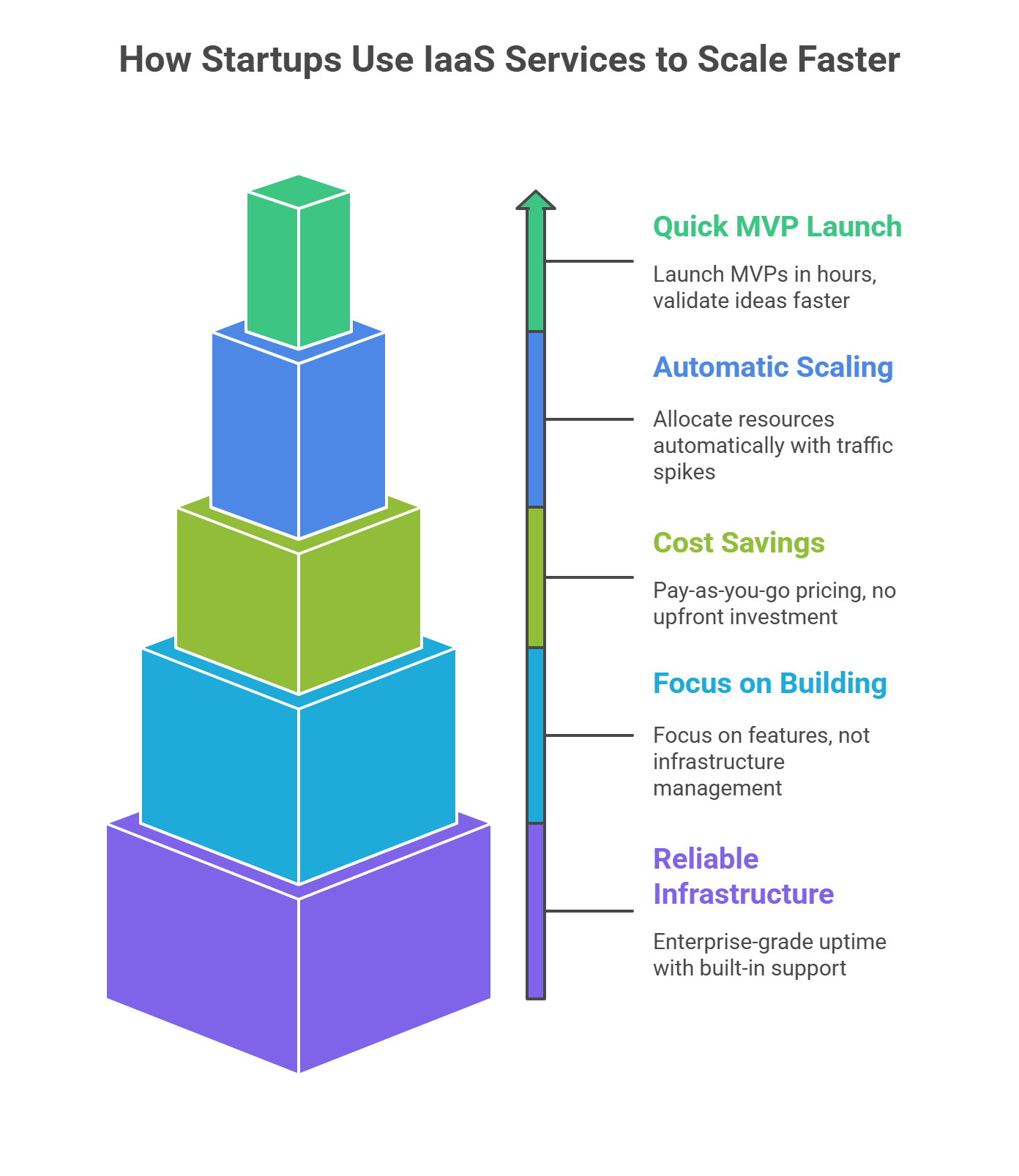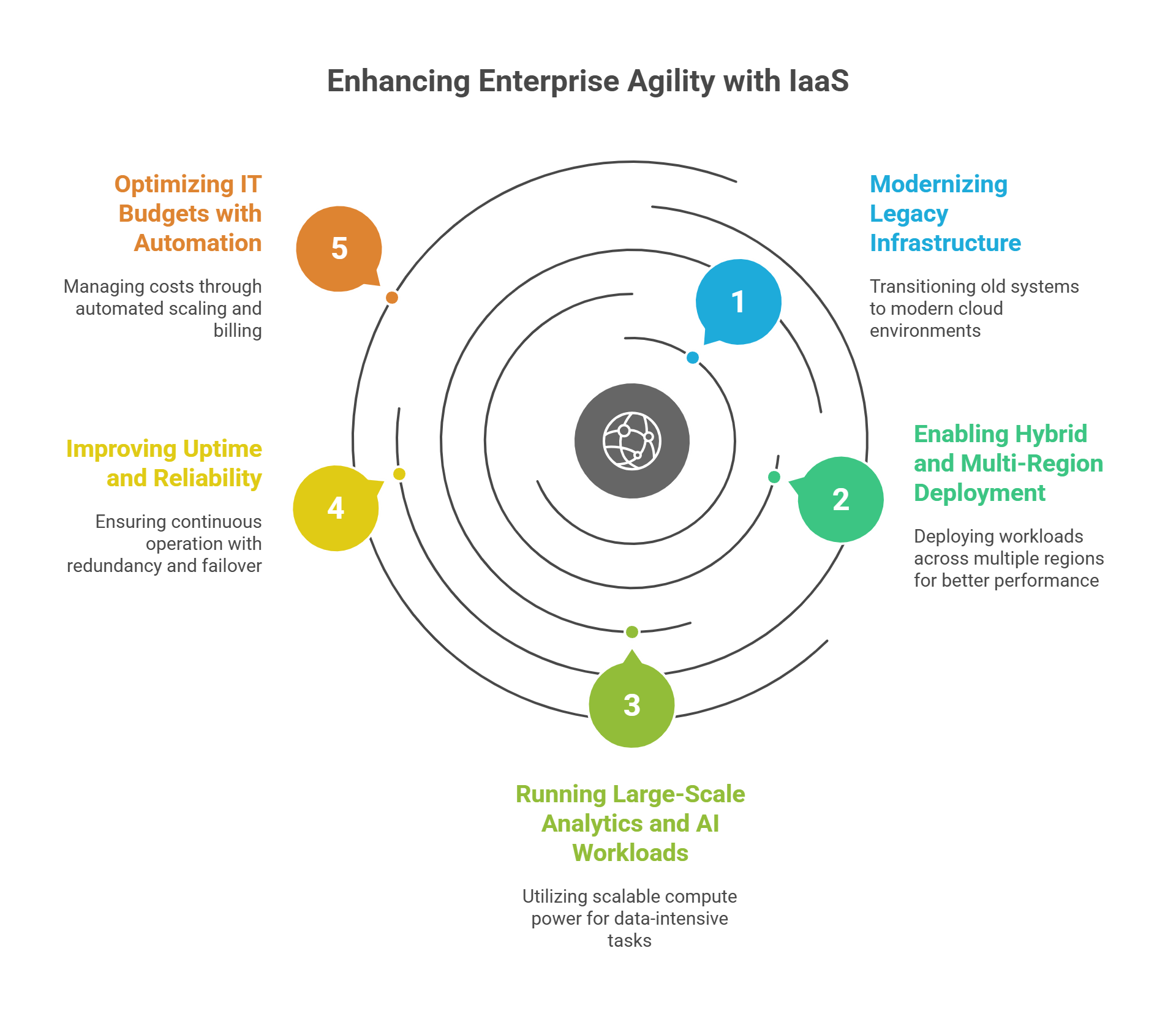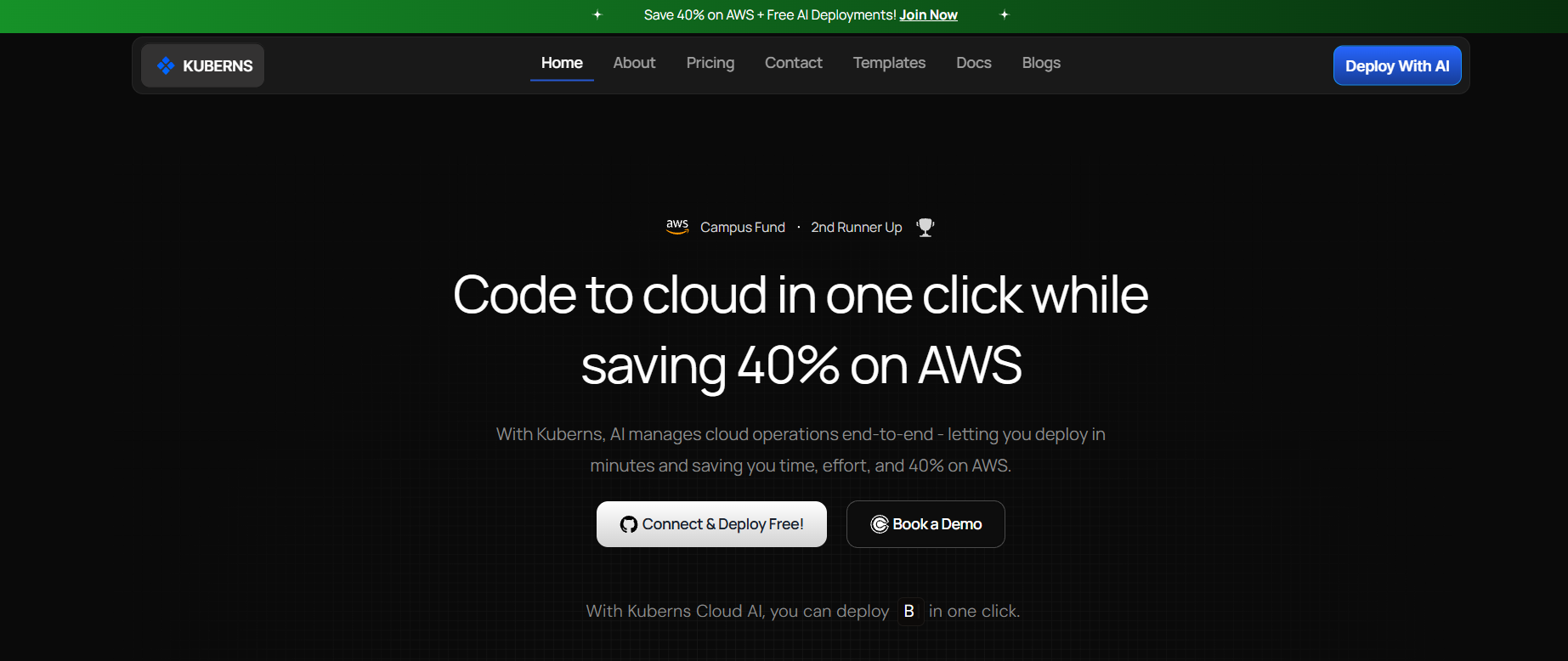Published
- 17 min read
How Startups and Enterprises Can Use IaaS Services to Scale Faster?

IaaS services have completely changed how startups and enterprises scale their applications today. Instead of spending months setting up servers and managing infrastructure, teams can now launch, test, and grow products in days, all with flexible cloud-based resources.
For a startup, this speed means getting to market faster and saving money early on. For an enterprise, it means handling growth without hitting infrastructure limits or unnecessary downtime.
The common goal is simple. Move fast without wasting time or budget on DevOps complexity.
That’s exactly what Infrastructure as a Service (IaaS) offers. It gives businesses the core building blocks of IT, compute, storage, networking, and monitoring, directly through the cloud. You use what you need, scale when demand increases, and only pay for the resources consumed.
In short, IaaS services help both new and established companies scale faster, control costs, and stay focused on innovation rather than infrastructure.
For a broader view of top platforms in this space, check out our guide on the Top 10 IaaS Cloud Providers in 2025
What Are IaaS Services and Why Businesses Choose Them?
 IaaS services, short for Infrastructure as a Service, provide the core infrastructure that businesses need to run applications, servers, storage, networking, and computing resources, all managed through the cloud.
IaaS services, short for Infrastructure as a Service, provide the core infrastructure that businesses need to run applications, servers, storage, networking, and computing resources, all managed through the cloud.
Instead of owning or maintaining physical hardware, you rent what you need from a provider and scale it up or down on demand.
This model has become the go-to choice for companies that want flexibility without upfront investment.
A developer can spin up a new environment in minutes, while enterprises can deploy global systems without maintaining massive data centers.
In simple terms, IaaS acts as the “foundation layer” of cloud computing. It’s what powers everything from internal business apps to SaaS products and even large-scale AI workloads.
Here’s why businesses are rapidly moving toward IaaS:
- Speed and agility: Deploy infrastructure in minutes, not weeks.
- Scalability: Automatically adjust capacity based on traffic or demand.
- Cost efficiency: Pay only for the resources you use instead of maintaining idle servers.
- Reliability: Built-in redundancy, uptime guarantees, and global data centre coverage.
- Security and compliance: Managed policies and encryption without complex setups.
For startups, this means faster launches. For enterprises, it means modernisation without disruption.
If you want to understand how to evaluate the right infrastructure setup, our guide on picking the best IaaS platform for your business covers the key decision points and features to look for.
How Startups Use IaaS Services to Scale Faster?
 For startups, every day counts. Most small teams don’t have dedicated DevOps engineers or the time to manage infrastructure manually.
For startups, every day counts. Most small teams don’t have dedicated DevOps engineers or the time to manage infrastructure manually.
That’s why IaaS services have become a game-changer. They make it possible to launch, scale, and optimize products without worrying about servers or hardware setup.
Here’s how startups benefit from IaaS in real terms:
1. Launch MVPs Quickly.
Instead of setting up data centres or configuring virtual machines manually, startups can use IaaS platforms to launch MVPs within hours. This helps validate ideas faster and cut time to market.
2. Scale Automatically with Growth
When user traffic spikes, IaaS platforms automatically allocate more compute power and storage. Once demand drops, they scale back down, keeping costs predictable and performance consistent.
3. Save Money from Day One
With pay-as-you-go pricing, startups only pay for what they use. There’s no need for upfront investment or long-term infrastructure commitments.
4. Focus on Building, Not Managing
Instead of spending days managing configurations, startups can focus entirely on building features and improving user experience while the infrastructure runs itself in the background.
5. Stay Reliable from the Start
Even small teams can achieve enterprise-grade uptime with IaaS services. Backups, monitoring, and global CDN support are often built in.
In short, IaaS gives startups the same infrastructure power that large companies use, without the cost or complexity.
That’s also why many teams now prefer managed platforms like Kuberns, which take IaaS one step further.
Instead of handling cloud setup manually, startups can connect their Git repository, deploy instantly, and let Kuberns manage scaling, monitoring, and optimisation automatically, saving both time and money.
How Enterprises Use IaaS Services for Global Agility?
 Large enterprises face a different kind of scaling challenge. They already have massive systems running, but they need to modernise, expand globally, and stay cost-efficient while maintaining performance.
Large enterprises face a different kind of scaling challenge. They already have massive systems running, but they need to modernise, expand globally, and stay cost-efficient while maintaining performance.
That’s exactly where IaaS services help.
Instead of relying on traditional on-prem data centres, enterprises are shifting to cloud-based IaaS platforms that give them flexibility, security, and automation at scale.
Here’s how enterprises typically use IaaS to achieve faster growth and agility:
1. Modernising Legacy Infrastructure Many enterprises still run legacy applications on physical servers. Moving these workloads to an IaaS environment allows them to modernise without rewriting everything from scratch. It’s a smooth path toward digital transformation.
2. Enabling Hybrid and Multi-Region Deployment Enterprises often operate in multiple countries or regions. With IaaS, they can deploy workloads close to users to reduce latency and improve performance, all while keeping a unified management layer.
3. Running Large-Scale Analytics and AI Workloads Data-driven enterprises rely on elastic compute power for analytics, AI models, and batch processing. IaaS services provide scalable GPUs and high-performance storage to handle these workloads efficiently.
4. Improving Uptime and Reliability Most IaaS providers offer built-in redundancy, failover, and 99.9% uptime guarantees. This helps enterprises maintain operational continuity even during traffic surges or system failures.
5. Optimising IT Budgets with Automation Enterprises use auto-scaling, load balancing, and usage-based billing to keep costs predictable. Instead of fixed capacity planning, they let the infrastructure expand and shrink automatically.
In short, IaaS helps enterprises achieve agility at a global scale, moving faster, reducing operational overhead, and staying resilient in changing market conditions.
To see how businesses choose the right enterprise-grade infrastructure, you can read our guide on the Best IaaS Cloud Hosting Solution for Businesses
Which IaaS Platform Helps Reduce Infrastructure Cost?
Cloud costs often start small and then quietly spiral out of control. It’s one of the most common pain points for both startups and enterprises using IaaS services.
What begins as a few instances running smoothly can quickly turn into an expensive, fragmented setup across compute, storage, and network components. Without smart cost control, teams end up paying for unused capacity or duplicate services they no longer need.
That’s why the question most businesses now ask is simple: Which IaaS platform actually helps reduce infrastructure cost without cutting performance?
Let’s break that down.
Below are key ways modern IaaS services help reduce infrastructure costs while keeping applications responsive and stable.
Pay-As-You-Go Efficiency
With traditional infrastructure, you often commit to hardware or server capacity upfront, regardless of whether you fully use it. This model locks up capital and forces you to predict future demand, something nearly impossible for startups or scaling teams.
IaaS platforms eliminate that guesswork. They operate on a pay-as-you-go model, where you’re billed based on hourly or even per-second resource usage. This means if your app only runs heavily during business hours or spikes occasionally, you only pay during those periods.
This flexible consumption model ensures every dollar spent directly supports business activity, not idle infrastructure.
Auto-Scaling to Avoid Waste
Scaling infrastructure manually often results in two bad choices. Either over-provision to prevent downtime or under-provision and risk slow performance. Both scenarios waste money or hurt user experience.
Auto-scaling, one of the core features of IaaS, removes that trade-off. It continuously monitors traffic, CPU load, and resource demand to adjust capacity in real time. When traffic surges, additional servers are launched instantly. When demand drops, those instances are automatically decommissioned.
This dynamic model prevents resource waste and ensures applications always have just enough power to perform efficiently. For example, an e-commerce app can handle peak shopping hours seamlessly and automatically scale down overnight, saving thousands each month.
Auto-scaling not only controls costs but also improves reliability by maintaining optimal performance during unexpected surges.
Spot and Reserved Instances
Another cost-saving option many IaaS platforms provide is flexible pricing tiers through spot and reserved instances. These allow teams to match workloads to the most cost-effective compute option.
- Reserved instances are ideal for predictable workloads. You commit to using specific resources for a longer period (like one or three years) in exchange for a much lower price, often up to 70% cheaper than on-demand rates.
- Spot instances, on the other hand, let you utilise unused capacity at massive discounts, sometimes 80–90% less than standard pricing. They’re perfect for non-critical, interruptible tasks like batch processing, analytics, or background jobs.
By strategically combining on-demand, reserved, and spot instances, organisations can strike the perfect balance between performance and affordability, without sacrificing reliability.
Centralized Monitoring and Optimization
Even the most efficient setup can become costly if usage isn’t monitored. That’s why modern IaaS services include built-in dashboards and analytics that track every component of your infrastructure, CPU, memory, storage, and bandwidth usage, in real time.
Centralised cost visibility helps teams identify waste early. Maybe one project is consuming more compute than expected, or a storage bucket has unnecessary data buildup. With proactive monitoring, you can take action before costs balloon.
Some platforms even allow budget alerts and cost anomaly detection, giving finance and engineering teams better control over spending. This transparency turns cloud usage from an unpredictable expense into a measurable, manageable cost centre.
However, even with these features, managing cost across multiple cloud components can become complicated. That’s where Kuberns make a difference.
Kuberns takes this optimisation to the next level.
 Built on AWS infrastructure, it uses intelligent resource allocation to ensure you only pay for what your applications truly need. It continuously analyses usage patterns and automatically optimises CPU, memory, and storage, achieving up to 40% savings without requiring manual tuning.
Built on AWS infrastructure, it uses intelligent resource allocation to ensure you only pay for what your applications truly need. It continuously analyses usage patterns and automatically optimises CPU, memory, and storage, achieving up to 40% savings without requiring manual tuning.
This approach replaces the need for complex FinOps or DevOps workflows. Developers can deploy directly from Git, and Kuberns handles everything else, from container setup and scaling to cost optimisation and monitoring.
Unlike traditional IaaS dashboards that require constant adjustment, Kuberns provides a transparent and automated layer that keeps infrastructure lean and efficient by default.
If your goal is to scale without the stress of rising cloud bills, Kuberns gives you a simple, AI-powered path to do it.
Real-World Scenarios
The real strength of IaaS services isn’t in theory. It’s in how businesses actually use them to scale faster, smarter, and more cost-effectively.
From early-stage startups to global enterprises, the same principle applies: infrastructure should accelerate growth, not slow it down.
Below are a few practical examples that show how different types of organisations are using IaaS platforms to scale efficiently and reduce operational costs.
Scenario 1: A SaaS Startup Scaling from 100 to 10,000 Users
A small SaaS team launches a new project management tool. In the beginning, they host it on a single shared server, but as users grow, performance issues start appearing, longer load times, database bottlenecks, and downtime during traffic spikes.
Switching to an IaaS platform changes everything. With on-demand compute and auto-scaling, the app automatically adjusts to user traffic. When usage spikes during business hours, additional instances spin up. When activity drops overnight, resources scale down to save cost.
Because everything runs on the cloud, the startup doesn’t need to hire extra DevOps engineers or invest in expensive hardware.
Within weeks, they handle a 100x growth in users while keeping performance stable and costs predictable.
Kuberns make this even simpler. The startup connects its Git repository, deploys the app in one click, and Kuberns handles the rest, provisioning, scaling, monitoring, and optimization. This allows the team to focus entirely on building features, not managing infrastructure.
Scenario 2: An Enterprise Expanding Across Multiple Regions
A large e-commerce enterprise wants to improve its global user experience. Their traffic spans North America, Europe, and Asia, but their infrastructure is centralised, causing latency and downtime for users far from the main server.
By moving to a multi-region IaaS setup, the company deploys infrastructure closer to users. Virtual machines and databases run in multiple availability zones, ensuring lower latency and faster response times. Load balancers distribute traffic intelligently, and backups replicate automatically between regions for resilience.
This setup not only improves performance but also supports data compliance and redundancy across markets. During peak sales seasons, auto-scaling ensures that traffic surges don’t overload servers. During off-hours, resources scale down, reducing unnecessary expenses.
With Kuberns, this enterprise could achieve the same outcome faster and at a fraction of the effort. The platform automates environment creation across regions, monitors usage continuously, and ensures all workloads scale intelligently, without the need for complex manual configuration.
Scenario 3: A Data and AI Company Running Heavy Compute Workloads
A mid-sized analytics company needs high-performance infrastructure to train AI models and process terabytes of data daily. Traditional infrastructure wasn’t flexible enough. Costs would skyrocket whenever they upgraded hardware.
By shifting to IaaS, the company gets access to GPU-powered instances on demand. They spin up resources during active training cycles and release them once completed. This elastic model prevents overpayment and makes experimentation affordable.
Additionally, IaaS platforms simplify data pipeline management, integrating storage, networking, and monitoring in one place.
For data-heavy workloads like this, Kuberns adds another layer of efficiency. It intelligently allocates compute resources to GPU-intensive processes and scales them automatically based on task priority and load. This results in faster model training times and significant cost savings on cloud compute usage.
The Takeaway
Across these examples, one thing remains constant. IaaS services help businesses scale on demand without friction. Startups move faster, enterprises operate globally, and data-driven companies gain the power to compute without constraints.
But managing all of this manually still takes time, tools, and expertise. Kuberns combine the best of IaaS flexibility with AI-driven simplicity, giving teams a one-click path to scale, optimise, and monitor everything automatically.
Whether you’re handling your first 100 users or your next 10 million, having the right IaaS foundation and the intelligence to manage it efficiently is what defines how fast your business can grow.
Most IaaS users face a common problem: rising AWS bills. Kuberns tackles this head-on through AI-driven resource optimisation. It intelligently right-sizes your instances, balances workloads, and eliminates idle consumption, leading to up to 40% savings on AWS costs without compromising reliability.
Conclusion
The way businesses scale today has completely changed, and IaaS services are at the heart of that transformation. Startups use them to launch faster with limited resources. Enterprises rely on them to modernise legacy systems and handle millions of users globally.
But as infrastructure grows, so does complexity. Managing servers, scaling policies, and cost optimisation manually can slow down even the best teams. That’s why more businesses are shifting toward AI-powered IaaS platforms that make scaling simple, automated, and cost-efficient.
Kuberns brings this future to life. Built on top of AWS, it lets you deploy directly from GitHub, scale automatically, and save up to 40% on cloud costs, all without managing DevOps pipelines or juggling multiple dashboards.
In short, if you want to scale faster, spend less, and operate smarter, the right IaaS foundation makes all the difference. With Kuberns, that foundation is already built for you.

Frequently Asked Questions
1. What are IaaS services used for in startups and enterprises?
IaaS services provide on-demand access to essential infrastructure like compute, storage, and networking, all managed through the cloud. Startups use them to launch and scale applications quickly without investing in hardware. Enterprises use IaaS to modernise legacy systems, expand globally, and handle workloads more efficiently.
2. How does IaaS help reduce infrastructure costs?
IaaS follows a pay-as-you-go model, which means you only pay for the resources you actually use. Combined with features like auto-scaling and resource monitoring, it prevents waste and ensures cost control. AI-powered platforms such as Kuberns go even further by automatically optimising resources to reduce cloud costs by up to 40%.
3. Which is the best IaaS platform for scaling applications?
The best IaaS platform depends on your use case. For teams seeking full control, AWS, Azure, and Google Cloud are strong options. But if you want a smarter, easier approach, where deployment, scaling, and monitoring are automated, Kuberns offers a simplified layer on top of AWS, combining performance with cost efficiency.
4. Can enterprises use IaaS for hybrid or multi-region deployment?
Yes. Most modern IaaS platforms allow multi-region and hybrid cloud setups. Enterprises can deploy workloads closer to their users to improve latency, ensure redundancy, and meet compliance requirements. With platforms like Kuberns, setting up multi-region environments becomes seamless and automated.
5. How does Kuberns make scaling easier for teams?
Kuberns automates the entire lifecycle of deployment from connecting your Git repository to scaling workloads intelligently. It manages compute, networking, and monitoring without any manual DevOps setup. This allows both startups and enterprises to scale faster, save on AWS costs, and maintain consistent performance with minimal effort.